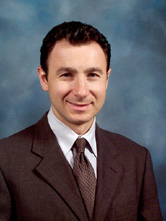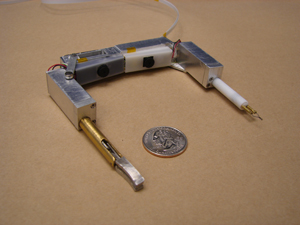 |
Dmitry Oleynikov, M.D. |
The concept behind NOTES is for surgeons to be able to perform a variety of surgical procedures through natural orifices such as the mouth. Some surgeons say NOTES may one day replace some traditional and laparoscopic surgeries.
NOTES has only been done in about 75 patients in the United States to date. A UNMC team led by Dmitry Oleynikov, M.D., associate professor of surgery and director of minimally invasive surgery, is trying to design superior NOTES tools.
“The goal is simple in NOTES, because you can go from minimally invasive surgery to non-invasive surgery,” Dr. Oleynikov said.
On Tuesday in San Diego at the Digestive Disease Week® 2008 conference, Dr. Oleynikov will be among three other surgeons presenting abstracts on various NOTES procedures.
The benefits of NOTES include surgery on an outpatient basis, surgery without pain and scarring and a way to perform procedures without incisions, he said.
Dr. Oleynikov will present an abstract on findings from a research study he and University of Nebraska-Lincoln engineer Shane Farritor, Ph.D., began about a year ago to test the safety and effectiveness of NOTES for abdominal surgeries in animal models. The results are promising.
 |
A mini-robot on a table with a camera and two working arms. |
The NOTES tools Drs. Oleynikov and Dr. Farritor are developing are robotic tools that can be placed in the mouth, move down the esophagus and into the stomach, where a small incision is made to gain access to the inner body and assist with surgery. The robot then exits the body the same way it entered. Stitching the incision would be done laproscopically, leaving no visible scars.
Current methods for NOTES involves using tools that aren’t well-suited for the job, Dr. Oleynikov said.
“A camera scope is used that is actually designed to remove polyps on the colon, not perform surgery,” he said. “Surgeons who use our NOTES robots will have the right tool for the job.”
For example, he said, the robotic device designed by he and Dr. Farritor could be used to remove portions of the colon that had cancer, it could remove the spleen, or it could repair a hernia.
In Dr. Oleynikov’s study, he used a small robotic device in animal models to perform more than 25 procedures including abdominal exploration, bowel manipulation, cholecystectomy and liver resection, without making cuts to the abdomen.
The devices, which are the size of two lipstick tubes, have central bodies, two working arms and a built-in light source. Each procedure was accomplished with at least two robots and endoscopic assistance.
Dr. Oleynikov’s team found their NOTES tools allowed for a better view inside the body during surgery.
While the device showed promise in this study, it has limitations, Dr. Oleynikov said. For example, while its small size allows it to reach areas that other devices cannot, the device is not large enough to move around larger organs, so more research will have to be done to make it more robust, especially for human use.
With successful FDA trials, the UNMC team’s NOTES technology might be available for human clinical trials in about two years.
The Digestive Disease Week® 2008 conference is jointly sponsored by the American Association for the Study of Liver Diseases, the American Gastroenterological Association (AGA) Institute, the American Society for Gastrointestinal Endoscopy and the Society for Surgery of the Alimentary Tract.
Kristin Francini of GYMR Public Relations contributed to this report.